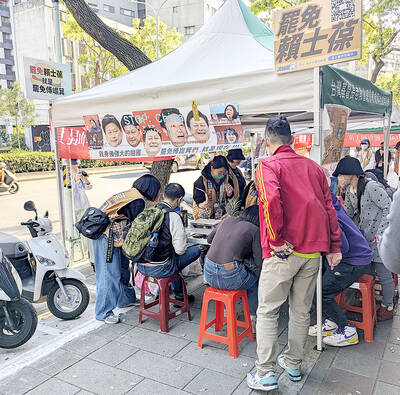The line between reality and fantasy was already blurred when Black Knight inhaled deeply, flexed in full armor and took a body builder's stance with his sword, his bleached-blond head looking toward a bright light only he could see in the far distance, while all around photographers took their best shots.
Around Black Knight, other animated dwarves, spirits, ghosts, puppets, TV, anime and manga characters struck poses and vogued their way from the changing rooms of National Taiwan University's gymnasium, down the long staircase to the campus below, and then for a walk around scenic Drunken Moon Lake (

Cosplay, a contraction of the words "costume" and "play" attracts mainly students, who choose a character they admire from popular culture, then dress in that person's clothes and pose at cosplay and comic-book conventions, or more recently at computer gaming shows. The cosplayers, in turn, attract photographers. There is no competition, no prizes, just the pleasures of showing off, watching and preserving a certain look for posterity.
Johnny Kou, aka Black Knight, is a 19-year-old student of mass communications and has been a cosplayer for four years. "I created all this myself, the character doesn't belong to any comic or magazine. It's a feeling I have which I express in different ways: Angelic and knightly, the two models combined into one," Kou said at the cosplay convention held at the end of last month in Taipei. "I enjoy the camera and being its focus. I also find it's a good way to make a lot of friends."
Two characters from a popular Japanese animation, a weekly for guys that usually features a babe in a bikini on the cover, were nearby. She was 16, he was 22 and they said they had met by coincidence at the convention. Now, they were posing together. They did not want to reveal their names but he said he had spent three to four months preparing the costume and it cost NT$3,000. She made her own outfit but had to buy the wig.
The vast majority of cosplayers are female and most of them said they dressed up because it was cute and as one bystander remarked, "It does show them to their best advantage."
Other reasons given were: to express their identities, to role play a perceived alter-ego, pay homage to a comic hero, fantasize, do something together, meet people, and often enough, "I just like dressing up."
Without the photographers, however, there would be no oxygen of publicity. They send their pictures to the cosplayers and put them up on Web sites, or compile photo magazines like Costier (
"I'm part of a camera association," said Hsieh Che-ming (謝哲明), pointing to a flock of photographers. "Yes, we follow them [the cosplayers]. Three or four of them are very attractive and good to photograph. We are very polite. We are not fakes, we know that not everyone wants to take good photos, to show up skirts, but we are respectable photographers and ask permission. We follow the color," he said and pointed to the satins and silks of a thousand costumes spread out over the campus before him.
Some of the cosplayers become minor stars and you can tell who the popular ones are because they attract the most photographers, with the heaviest
equipment. When a cosplayer's photo is published it often offers a small amount of information along the lines of: "Character: Pia, sweet carrot type," followed by something about the cosplayer, how long she's been doing it, why she likes it and what other hobbies she has.
Cosplay is variously said to have started in Japan in the 1930s, when there was a fad for dressing up as train conductors; or in the US at 1970s Star Trek conventions. It is undeniably Japan, however, that now leads the world in terms of cosplay. The activity has spawned an industry for publishing, marketing, costuming and conventions. The Associated Press estimates there are 50,000 cosplayers in Japan, but they are everywhere, often connected on the Internet.
An informal poll of magazine owners and event organizers at the Taipei cosplayer convention suggested around 4,000 core cosplayers are presently active in Taiwan. Most said the activity was becoming popular, partly because Japanese pop products are fashionable with the teen market.
In the main hall of the NTU gymnasium there were about 150 stalls and display areas selling obscure student comics, mainstream publishing houses, sticker and novelty item retailers.
Winnie from Taiwan and Yakata from Japan were manning Gravitational's stand. "We make computer montages of characters to make posters and calendars and stuff. It's like this five times or more a year. I've been doing this for eight years," Winnie said. "The cosplayers? They're very shiny and good for business."
Future cosplay events:
Feb. 28 and Feb. 29: 10am to 4pm, at Xinyi Primary School (
March 13: Taipei Main Station, Underground plaza 12.
http://www.comicworld.com.tw
May 1 and May 2
Taipei World Trade Center (
Exhibition Hall 2 (02) 2731 0117 www.f-2.com.tw

That US assistance was a model for Taiwan’s spectacular development success was early recognized by policymakers and analysts. In a report to the US Congress for the fiscal year 1962, former President John F. Kennedy noted Taiwan’s “rapid economic growth,” was “producing a substantial net gain in living.” Kennedy had a stake in Taiwan’s achievements and the US’ official development assistance (ODA) in general: In September 1961, his entreaty to make the 1960s a “decade of development,” and an accompanying proposal for dedicated legislation to this end, had been formalized by congressional passage of the Foreign Assistance Act. Two

Despite the intense sunshine, we were hardly breaking a sweat as we cruised along the flat, dedicated bike lane, well protected from the heat by a canopy of trees. The electric assist on the bikes likely made a difference, too. Far removed from the bustle and noise of the Taichung traffic, we admired the serene rural scenery, making our way over rivers, alongside rice paddies and through pear orchards. Our route for the day covered two bike paths that connect in Fengyuan District (豐原) and are best done together. The Hou-Feng Bike Path (后豐鐵馬道) runs southward from Houli District (后里) while the

The Taipei Times last week reported that the Control Yuan said it had been “left with no choice” but to ask the Constitutional Court to rule on the constitutionality of the central government budget, which left it without a budget. Lost in the outrage over the cuts to defense and to the Constitutional Court were the cuts to the Control Yuan, whose operating budget was slashed by 96 percent. It is unable even to pay its utility bills, and in the press conference it convened on the issue, said that its department directors were paying out of pocket for gasoline

On March 13 President William Lai (賴清德) gave a national security speech noting the 20th year since the passing of China’s Anti-Secession Law (反分裂國家法) in March 2005 that laid the legal groundwork for an invasion of Taiwan. That law, and other subsequent ones, are merely political theater created by the Chinese Communist Party (CCP) to have something to point to so they can claim “we have to do it, it is the law.” The president’s speech was somber and said: “By its actions, China already satisfies the definition of a ‘foreign hostile force’ as provided in the Anti-Infiltration Act, which unlike